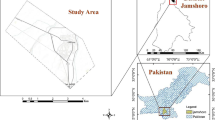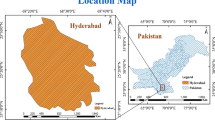Abstract
Present study was carried out to explore heavy metals pollution and potential ecological risk factors associated with agriculture soil irrigated with industrial effluents of Hayatabad industrial estate, Peshawar (HIEP) and Gadoon industrial estate, Sawabi (GIES) of Khyber-Pakhtunkhwa, Pakistan through multivariate geo-statistical tools. Diverse statistical tools like cluster analysis (HC) and principal component analysis (PCA), along with geo-statistical approaches were applied to highlight the geogenic and anthropogenic sources of pollution. The results indicated that concentration of heavy metals in target areas was significantly higher than control. Both soils had significant to moderate enrichment of heavy metals, while Gadoon soil had moderate to considerable ecological risk factor. The geo accumulation indices (Igeo) tendency for heavy metals in both target soil (Gadoon and Hayatabad) were the same. The Pb concentration of both target areas falls in the extremely severely polluted category because of the excessive presence of industries producing lead-containing products. Hence, this study indicated that the majority of toxic heavy metals contributed to soil pollution in the studied areas are coming from industrial and commercial activities.









Similar content being viewed by others
Availability of data and material
All the data is contained within the article.
References
Ameh, E. G., Kolawole, M. S., & Imeokparia, E. G. (2011). Using factor-cluster analysis and enrichment methods to evaluate impact of cement production on stream sediments around obajana cement factory in kogi state, north central Nigeria, pelagia research library. Advances in Applied Science Research, 2, 76–89.
Amin, N., Dawood, I., & Sultan, A. (2014). Heavy metals accumulation in soil irrigated with industrial effluents of Gadoon industrial estate, Pakistan and its comparison with fresh water irrigated soil. Journal of Agricultural Chemistry and Environment, 3, 80–87.
Atgin, R. S., El-Agha, O., Zararsiz, A., Kocatas, A., Parlak, H., & Tuncel, G. (2000). Investigation of the sediment pollution in Izmir bay: trace elements. Spectrochimica Acta Part B, 55, 1151–1164.
Banat, K. M., Howari, F. M., & Al-Hamada, A. A. (2005). Heavy metals in urban soils of central jordan; should we worry about their environmental risks. Environmental Research, 97, 258–273.
Barbieri, M. (2016). The importance of enrichment factor (EF) and geo accumulation index (Igeo) to evaluate the soil contamination. Geology & Geophysics, 5, 1–4.
Cabrera, F., Clemente, L., & Barrientos, D. E. (1999). Heavy metal pollution of soils affected by the guadiamar toxic flood. Science of Total Environment, 242, 117–129.
DeVolder, P. S., Brown, S. L., Hesterberg, D., & Pandya, K. (2003). Metal bioavailability and speciation in a wetland tailings repository amended with biosolids compost, wood ash, and sulfate. Journal of Environment Quality, 32, 851–864.
E.P.A. (1996) Method 3050B: Acid Digestion of Sediments, Sludges, and Soils, Rev 2.
Fagbote, E. O., & Olanipekun, E. O. (2010). Evaluation of the status of heavy metal pollution of soil and plant (chromolaenao dorata) of agbabu bitumen deposit area, Nigeria. European Journal of Scientific Research, 5, 241–248.
Hakanson, L. (1980). An ecological risk index for aquatic pollution control; a sedimentological approach. Water Research, 14, 975–1001.
Harikumar, P. S., Nasir, U. P., & Rahman, M. P. (2009). Distribution of heavy metals in the core sediments of a tropical wetland system. International Journal of Environment Science and Technology, 6, 225–232.
He, M. L., Mir, P. S., Beauchemin, K. A., Ivan, M., & Mir, Z. (2005). Effects of dietary sunflower seeds on lactation performance and conjugated linoleic acid content of milk. Canadian Journal of Animal Science, 85, 75–83.
Hussain, R., Khattak, S. A., Shah, M. T., & Ali, L. (2015). Multistatistical approaches for environmental geochemical assessment of pollutants in soils of Gadoon amazai industrial estate, Pakistan. Journal of Soils and Sediments, 15, 1119–1129.
Iqbal, J., & Shah, M. H. (2011). Distribution, correlation and risk assessment of selected metals in urban soils from Islamabad, Pakistan. Journal of Hazardous Materials, 192, 887–898.
Jabeen, S. (2013) Environmental geochemistry of Attock and Haripur basins, Pakistan. Ph.D thesis, National Centre of Excellence in Geology, University of Peshawar, Pakistan
Jahangir, M., Abdel-Farid, I. B., de Vos, C., Jonker, H. H., Choi, Y. H., & Verpoorte, R. (2014). Metabolomic variation of Brassica rapa var. rapa (var. raapstelen) and Raphanus sativus L. at different developmental stages. Pakistan Journal of Botany, 46, 1445–1452.
Konwar, D., & Jha, D. K. (2010). Response of rice (Oryza sativa L.) to contamination of soil with refinery effluents under natural conditions. Journal of Biodiversity and Environmental Sciences, 5, 14–22.
Lambert, M., Leven, B. A., & Green, R. M. (2000). New methods of cleaning up heavy metal in soils and water; environmental science and technology briefs for citizens. Kansas State University. USA.
Mahfooz, Y., Yasar, A., Guijian, L., Islam, Q., Akhtar, A. B. T., Rasheed, R., Irshad, S., & Naeem, U. (2020). Critical risk analysis of metals toxicity in wastewater irrigated soil and crops: a study of a semi-arid developing region. Scientific Report, 10, 12845.
Malik, D.M., Ahmed, B., & Ahmed, M. (1984). Survey of soil fertility status and quality of ground waters in Punjab. Digest 1981–84, Department of Agriculture, Lahore.
Malook, I., Rehman, S. U., Khan, M. D., El-Hendawy, S. E., Al-Suhaibani, N. A., Aslam, M. M., & Jamil, M. (2017). Heavy metals induced lipid peroxidation in spinach mediated with microbes. Pakistan Journal of Botany, 49, 2301–2308.
Mico, C., Peris, M., Recatala, L., & Sanchez, J. (2007). Baseline values for heavy metals in agricultural soils in an european mediterranean region. Science of Total Environment, 378, 13–17.
Naveedullah, Hashmi, M. Z., Yu, C., Shen, H., Duan, D., Shen, C., Lou, L., & Chen, Y. (2013). Risk assessment of heavy metals pollution in agricultural soils of siling reservoir watershed in Zhejiang province, China. BioMed Research International. https://doi.org/10.1155/2013/590306
Nawaz, S., Ali, S. M., & Yasmin, A. (2006). Effect of industrial effluents on seed germination and early growth of Cicer arientum. Journal of Biosciences, 6, 49–59.
Nelson, D. W., & Sommers, L. E. (1982). Total carbon, organic carbon and organic matter methods of soil analysis, chemical and microbiological properties. Madison, Soil. https://doi.org/10.2134/agronmonogr9.2.2ed.c29
Niroula, B. (2003). Comparative effect of industrial effluents and submetropolitan sewage of biratnagar on germination and seedling growth of rice and blackgram. Our Nature, 1, 10–14.
Odigi, M. I., Ukrem, L. O., & Nwankwoala, H. O. (2011). Distribution of heavy metals in soils of port harcourt and its environs, niger delta, Nigeria. Chinese Journal of Geochemistry, 30, 415–429.
Qiao, M., Cai, C., Huang, Y., Liu, Y., Lin, A., & Zheng, Y. (2011). Characterization of soil heavy metal contamination and potential health risk in metropolitan region of northern China. Environmental Monitoring and Assessment, 172, 353–365.
Rehman, W., Zeb, A., Noor, N., & Nawaz, M. (2008). Heavy metal pollution assessment in various industries of Pakistan. Journal of Environmental Geology, 55, 353–358.
Sabeen, M., Mahmood, Q., Ebadi, A. G., Bhatti, Z. A., Irshad, M., Kakar, A., Bilal, M., Arshad, H. M., & Shahid, N. (2019). Health risk assessment consequent to wastewater irrigation in Pakistan. Soil and Environment, 39(1), 67–76.
Schnitzer, M. (1978). Humic substances: chemistry and reactions. Developments in soil science (pp. 1–64). New York: Elsevier Scientific Publishing Company.
Seifi, M. R., Alimardani, R., & Sharifi, A. (2010). How can soil electrical conductivity measurements control soil pollution? Research Journal of Environmental and Earth Sciences, 2, 235–238.
Sharma, R. K., Agrawal, M., & Marshall, F. (2007). Heavy metal contamination of soil and vegetables in suburban areas of Varanasi, India. Ecotoxicology and Environmental Safety, 66, 258–266.
Soltanpour, P. N., & Schwab, A. P. (1997). A new soil test for simultaneous extraction of macro- and micronutrients in alkaline soils. Communications in Soil Science and Plant Analysis, 8, 195–207.
Sutherland, R. A. (2000). Bed sediment and associated trace metals in an urban stream, Oahu Hawaii. Journal of Environmental Geology, 39, 611–627.
Tariq, S. R., Shah, M. H., Shaheen, N., Khalique, A., Manzoor, S., & Jaffar, M. (2006). Multivariate analysis of trace metal levels in tannery effluents in relation to soil and water- a case study from Peshawar, Pakistan. Journal of Environmental Management, 79, 20–29.
Tejowulan, R. S., & Hendershot, W. H. (1998). Removal of trace metals from contaminated soils using EDTA incorporating resin trapping techniques. Environmental Pollution, 103, 135–142.
Tokaliogˇlu, Ş, Kartal, Ş, & Güneş, A. A. (2001). Determination of heavy metals in soil extracts and plant tissues at around of a zinc smelter. International Journal of Environmental Analytical Chemistry., 80(3), 201–217.
Tomlinson, D. L., Wilson, J. G., Harris, C. R., & Jeffrey, D. W. (1980). Problem in assessment of heavy-metal levels in estuaries and the formation of a pollution index. Environmental Evaluation, 33, 566–575.
US Salinity Laboratory Staff (1954) Diagnosis and improvement of saline and alkali soils. US Department of Agriculture Handbook 60, Washington, DC.
Weggler, K., McLaughlin, M. J., & Graham, R. D. (2004). Effect of chloride in soil solution on the plant availability of biosolid-borne cadmium. Journal of Environmental Quality, 33, 496–504.
Wong, C. S. C., Li, X. D., Zhang, G., Qi, S. H., & Peng, X. Z. (2003). Atmospheric deposition of heavy metals in the pearl river delta, China. Atmospheric Environment, 37, 767–776.
Zhang, J., & Liu, C. L. (2002). Riverine composition and estuarine geochemistry of particulate metals in China-weathering features, anthropogenic impact and chemical fluxes. Estuarine, Coastal and Shelf Science, 54, 1051–1070.
Funding
The current study was fully supported by higher education commission, Pakistan through research grant number 20–4372.
Author information
Authors and Affiliations
Contributions
M.J., wrote the manuscript, author was involved in planning and supervised the work, the main conceptual ideas and proof outline; I.J. and M.F. carried out the experiment; M.M.A., Author helped in performing the experiments; S.U.R. and M. D. K., authors provided critical feedback and helped to shape the research; E.S.R., author provided critical feedback.
Corresponding author
Ethics declarations
Conflict of interest
The authors declare that there is no conflict of interests regarding the publication of this paper.
Additional information
Publisher's Note
Springer Nature remains neutral with regard to jurisdictional claims in published maps and institutional affiliations.
Rights and permissions
About this article
Cite this article
Jamil, M., Malook, I., Rehman, S.U. et al. Multivariate geo-statistical perspective: evaluation of agricultural soil contaminated by industrial estate’s effluents. Environ Geochem Health 44, 57–68 (2022). https://doi.org/10.1007/s10653-021-01007-9
Received:
Accepted:
Published:
Issue Date:
DOI: https://doi.org/10.1007/s10653-021-01007-9




